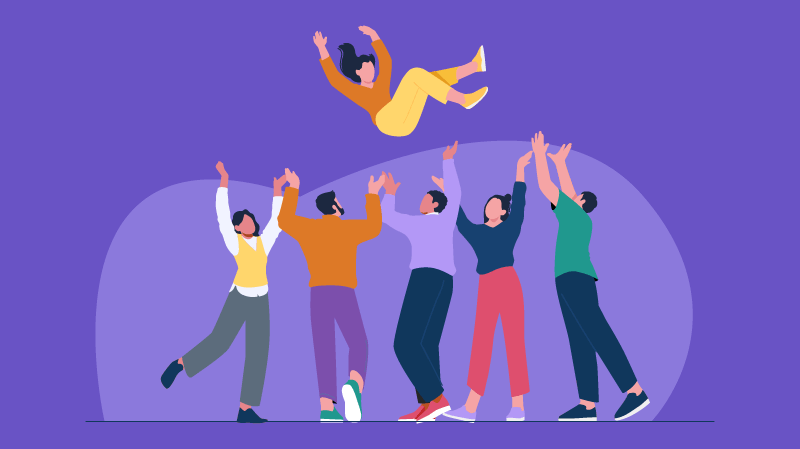Employee Engagement Made Easy: 18 Best Practices
Picture this: You stroll into the office, and your colleagues greet you with high-fives and cheers. Your boss is more like a mentor than a manager. Sounds like a dream, right? Turns out, it's not just a pipe dream!
Your work is going to fill a large part of your life, and the only way to be truly satisfied is to do what you believe is great work.
– Steve Jobs
Employee engagement is increasingly becoming innovative and thrilling, and workplaces have evolved from drab cubicles to vibrant talent communities. In modern business, great work starts with engagement, and the numbers don't lie; engaged employees are 87% less likely to leave their companies.
Before we dig deeper into this transformative concept, we should get the basics right by understanding what employee engagement is!
Employee engagement is a strategic approach that can profoundly impact your organization's success. It's more than just a feel-good factor. It is all about how committed and enthusiastic employees are in their jobs.
It's important in any organization because engaged employees work harder and are more satisfied. They contribute more ideas, cooperate better with their colleagues, and help the company succeed. Engaged employees tend to stay longer with the company, which saves on hiring and training costs.
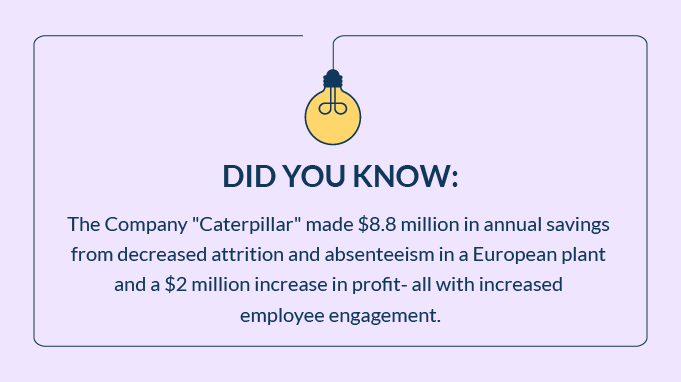
So, buckle up as we journey through the most exciting and effective employee engagement practices that will transform your workplace.
1. Begin with Yourself
Employee engagement begins with you. As a manager or leader within your organization, your role is pivotal in shaping the work environment and fostering a culture that encourages commitment, motivation, and productivity among your team members.
It's not just about setting expectations and goals; it's about leading by example and continuously seeking opportunities for self-improvement.
- Managers should engage in self-assessment regularly.
- Continuous learning and development are crucial.
- Encourage leadership training at all levels.
- Encourage employees to take ownership and initiative in their roles.
- Promote a culture of feedback and self-improvement.
Statistics:
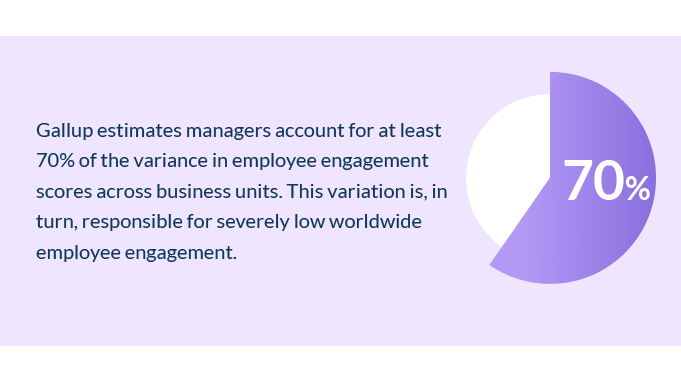
Let us see some real-life examples of this;
At companies like Microsoft, top leadership, including CEO Satya Nadella, emphasizes the importance of personal growth in transforming company culture.
Yousician, a Finnish interactive and educational music service, took its entire team to Saarenmaa, Estonia, for team bonding and to discuss improving its product. When the company discovered their office in Helsinki would undergo a one-month renovation, they decided to get creative. With offices in Finland being expensive enough for them to book a month's space, CEO Christoph Thür rented an entire villa in Greece and flew the whole team, alongside their families, to work for a month.
The CEO of Cheesecake Factory, an American restaurant company, says that training and recognition are high on the priority list within the organization because employees who feel appreciated tend to give better service, which improves customer satisfaction and further increases the reputation.
2. Extend the Helping Hand
As a manager, you already understand the significance of your role in shaping your team's success.
But beyond just setting objectives and offering guidance from a distance, a profound element can elevate your team's performance and satisfaction: extending a helping hand through nurturing a coaching culture. Ensure that you;
- Establish mentorship programs for new employees.
- Encourage cross-departmental collaborations.
- Create platforms for knowledge sharing.
- Foster a culture of mutual support and learning.
Statistics:
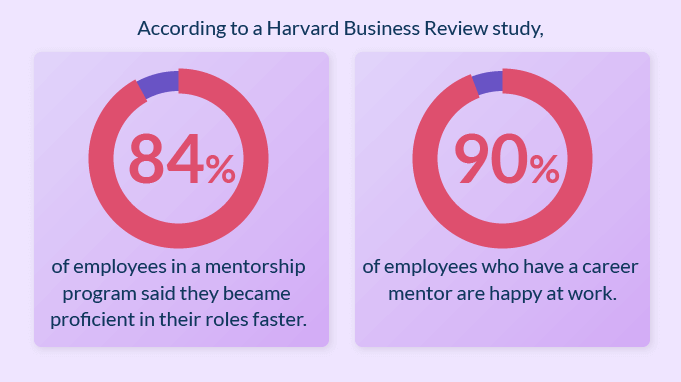
Example:
Google's peer-to-peer learning program exemplifies a culture of collaboration and mutual growth. The g2g program ("Googlers-to-Googlers") is an internal volunteer teaching network that dedicates a portion of their time to helping their peers learn and grow, all outside of their core job responsibilities. Nearly 80% of all internal training at Google is provided through the g2g community - whether by teaching courses, providing 1:1 mentoring, or designing learning materials.
Companies like LinkedIn have mentorship programs where seasoned professionals guide newer employees. Like their job postings, LinkedIn lists mentorship opportunities where interested members can apply to mentor youth through existing programs in various industries.
3. Exercise On-Spot Recognition
As a manager, you already understand the significance of your role in shaping your team's success.
But beyond just setting objectives and offering guidance from a distance, a profound element can elevate your team's performance and satisfaction: extending a helping hand through nurturing a coaching culture. Ensure that you;
- Daily stand-ups can include moments of appreciation.
- Implement instant reward systems.
- Use digital platforms for peer recognition.
- Celebrate small wins as much as big achievements.
Statistics:
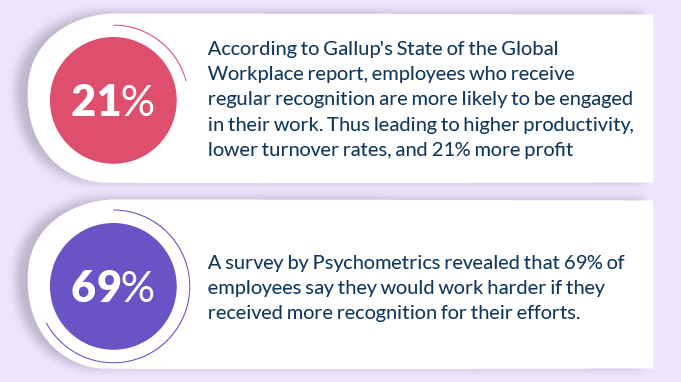
Example:
Numerous companies have adopted O.C. Tanner's recognition platform to facilitate immediate peer recognition.
Zappos employees are called 'Zapponians,' and some of its unique peer-to-peer programs include
Zollar Program: Zollars (or Zappos Dollars) is play money that Zapponians can share.
Coworker Bonus Program: Zapponians can reward one another with a $50 coworker bonus. They can give each other a maximum of one bonus per month, but they can receive more than one as long as different people give them.
Facebook has a recognition program called "Facebook Applause." Employees can give "Applause" to their colleagues for going "above and beyond" in their roles, and the recognized employee receives a notification and appreciation message.
Employee Engagement company Vantage Circle offers peer-to-peer recognition as one of its unique functionalities to its users. Employees can acknowledge their peers with the help of different badges on the platform and spot award team members with just a click.
Recommended Resource: To know more about how you can implement a peer-to-peer recognition program, you can read it here
4. Maintain Transparency
Transparency is the game-changer. As a manager, you can create a culture of open and honest communication.
By maintaining transparency, you provide your team with the valuable insights they need to understand the 'why' behind the 'what' and 'how' of their work. It fosters a sense of inclusiveness and respect, showing your team that their opinions and concerns matter.
- Conduct regular town hall meetings.
- Share company financials and strategies openly.
- Establish a company communication platform for sharing updates, news, and resources.
- Encourage open-door policies and provide context for major organizational changes, outlining the "why" behind decisions.
- Address employee concerns transparently.
Statistics:
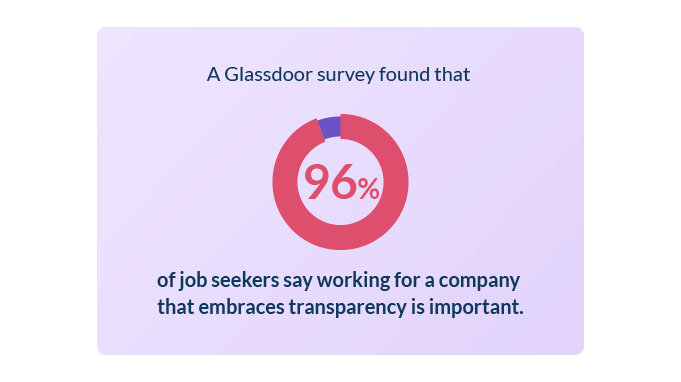

Example:
Software application firm Buffer's open salary policy showcases the power of transparency in building trust.
T-Mobile regularly hosts town hall meetings where employees can ask executives any questions.
Superhuman, an email app, champions transparency by sharing information through its "public roadmap," allowing users to see features and provide feedback on what they'd like.
Zappos, an online shoe and clothing retailer, created an employee-written blogosphere. Within this forum, readers stay up to date on the inner workings of the entire business. Zappos even made public this letter from the CEO to employees when Amazon bought the company.
Learn More:The 9 Best Employee Morale Boosters That Really Work
5. Freedom to Make Choices
Alongside transparency, the freedom to make choices is crucial in employee engagement
As a manager, you have the power to cultivate an environment where your team members feel trusted and empowered to make decisions within their roles. Now, for that to happen, you can;
- Offer flexible work schedules.
- Allow autonomy in project approaches.
- Encourage employees to take ownership of their roles.
- Provide opportunities for cross-functional projects.
Statistics:
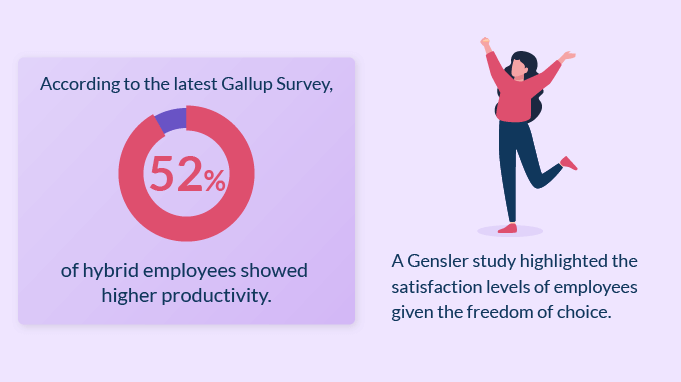
Example:
Netflix offers its salaried employees as much paid time off as they wish. In an emergency, its employees don't have to go through a formal process to apply for leave; they can take a day off. Netflix's unlimited vacation policy is a testament to the company's trust in its employees.
Similarly, Hubspot employees enjoy unlimited holidays, flexible work agreements, and well-being perks. They also enjoy four extra weeks of paid leave every five years they stay with the company.
Square Root, another software company, encourages employees to learn more about topics that interest them through its Learn Anything program.
6. Make Recognition a Daily Affair
Recognition in employee engagement is a powerful tool that fosters motivation and job satisfaction
Consistent recognition is the key to sustaining employee engagement. As an organization, you must highlight daily recognition's profound impact and how it contributes to a motivated and dedicated workforce. You can;
- Dedicate channels for daily achievements.
- Encourage team members to appreciate peers.
- Highlight team successes in company newsletters.
- Organize monthly recognition events
Statistics:

Example:
The CEO of Black n Bianco, a luxury children's formal wear brand, personally honors each employee for a job well done.When the online seller secured a large purchase order, the CEO gave each team member a handwritten letter and performance bonus to show her appreciation for their hard work and dedication.
Disney delivers a small, sincere "thank you" consistently to its people, which lies at the base of their employee recognition programs. The thank you is followed up with special-edition pins for name tags, custom-made trophies, and VIP "Service Celebrations" designed to reward those employees who go above and beyond.
7. Good Internal Communication is the Key
Imagine a workplace where everyone is on the same page, ideas flow freely, and everyone feels heard. Effective communication within the organization can break down silos and enhance teamwork. An organization can ensure seamless communication flow to its employees if the management ;
- Ensure that employees have easy access to information.
- Two-way feedback is important. Encourage employees to voice their opinions and concerns.
- Encourage departments to share weekly updates.
- Organize regular inter-departmental meetings to foster unity.
Statistics:
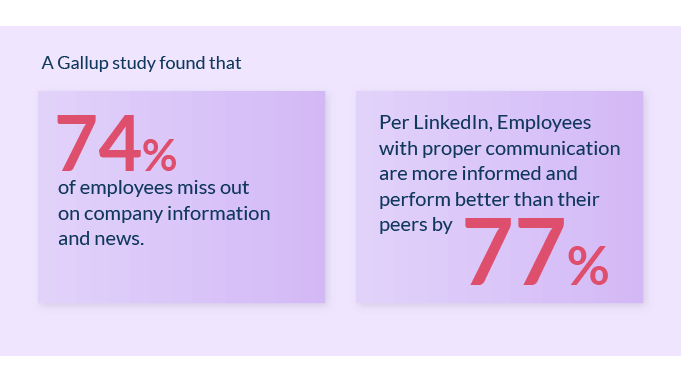
Example:
Many companies have adopted tools like Slack for real-time communication, creating channels for different teams and projects.
Atlassian, an Australian software company, uses its product, Confluence, to maintain transparency and ensure everyone is on the same page.
Software giant Adobe's Check-in approach, which replaced annual reviews, focuses on regular feedback and caters to individual employee needs.
8. Practice Engagement from Day One
Start from day one! Whether through a warm welcome, a buddy system, or a personalized onboarding process, this practice creates a sense of belonging and purpose right from the get-go. To make the new hires feel like part of the family, organizations can;
- Make onboarding engaging and informative.
- Introduce new hires to company culture and values.
- Organize team introductions and ice-breaking sessions.
- Provide clear guidelines and resources for new employees.
Statistics:
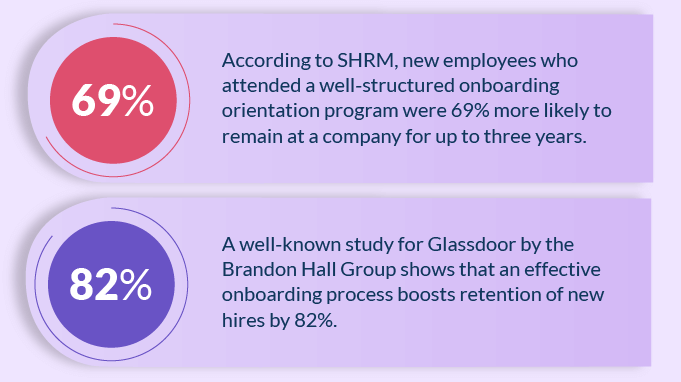
Example:
Cloud Software Company Salesforce has an elaborate onboarding process called "Trailhead," which gamifies the learning experience for new hires.
From the start, Warby Parker, the retailer of prescription glasses, contact lenses, and sunglasses, used various tactics to build peer-to-peer connections among team members. Balloons with the words "Nice to meet you!" are placed on the desk of each recruit to alert the rest of the staff that they should go out of their way and say hello.
9. One Size Doesn't Fit All
Personalization is the key to unlocking the full potential of your team and fostering a culture where everyone feels like they truly belong. As an organization, it's important to understand that every employee is unique and design engagement strategies to suit individual preferences.
- Tailor engagement efforts to individual preferences.
- Gather feedback to understand what motivates each employee
- Customize engagement strategies for different teams.
- Offer flexible benefits that cater to diverse needs.
- Encourage managers to adopt a personalized approach to leadership.
Statistics:
As per Forbes, Employees who feel their voice is heard are 4.6 times more likely to feel empowered to perform their best work.
A Deloittestudy found that 83% of executives and 84% of employees rank having engaged and motivated employees as the top factor that substantially contributes to a company's success.
Example:
BetterUp, a coaching platform, offers its employees unique benefits, including pet insurance, infertility HRA, and student loan financing. As a mission-driven company based on improving the human experience, BetterUp prioritizes work-life balance. The company also offers virtual coaching to every full-time employee, a remote workplace, unlimited PTO, and Inner Work® Days to support employees' well-being.
Patagonia, a clothing brand, provides many appealing employee benefits to keep teams engaged. The company's on-site childcare center is the most significant perk. Employees are welcome to visit their children during lunch breaks or to tuck them in for sleep. Nursing mothers are even notified if their infants need to eat by the daycare.
10. Emphasize Employee Health and Wellness
When you emphasize employee health and wellness, you say, "We care about you!". By embracing wellness, you can improve the overall quality of life of your employees; some practices include;
- Offer wellness initiatives and resources.
- Provide access to counseling and mental health resources.
- Implement regular health check-ups.
- Encourage breaks and time off for rejuvenation.
Statistics:
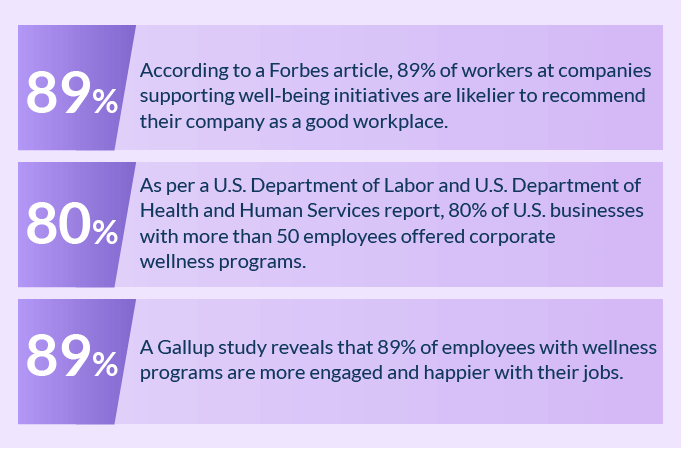
Example:
Johnson & Johnson's wellness program has reportedly saved the company $250 million on healthcare costs over the past decade.
Tech giants like Google provide on-site wellness and fitness centers, promoting a healthy work-life balance. The company offers Free food on campus, Cooking classes, A gym with free classes, Celebrity talks, and Massage therapists. It also supports employees' families. It offers a generous death benefit that pays a deceased employee's spouse or partner 50% of their salary for 10 years.
11. Define Goals and Acknowledge Achievements
It's all about setting clear goals and acknowledging the victories, big or small. Defining objectives and recognizing accomplishments helps foster job satisfaction and a shared sense of accomplishment within the organization. Thus, to keep employees inspired and driven, it is important to;
- Set performance goals and expectations.
- Celebrate milestones, both big and small.
- Provide feedback on performance regularly.
- Offer training for skill enhancement.
Statistics:
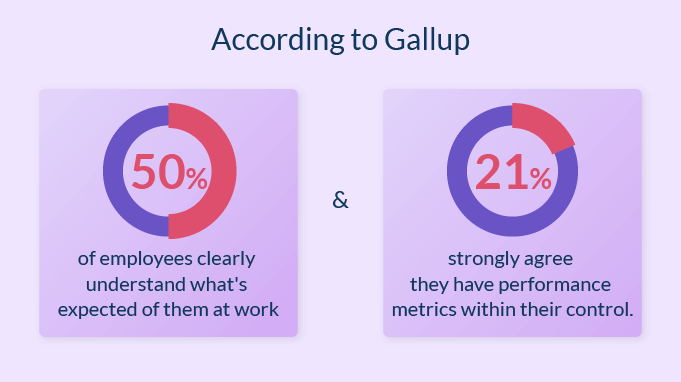
Example:
Many companies use platforms like Asana or Trello to track goals and celebrate task completions.
Into the AM, an apparel brand has created a full-time position called "Director of Happiness." The primary responsibility of the position is team member engagement and morale. They have also ensured that clear goals are set for each team member, which are measurable and broken down annually and quarterly. As a result, every team member knows what winning looks like.
In addition to the usual salaries, Apple has rolled up some of its employees' best perks and incentives. The company offers free stock shares to all employees with grants of up to $2,000. All these unique benefits make the employees feel part of the company, promoting employee engagement in their work.
12. Thrive for a Healthy Work Environment
By nurturing a culture where employees feel supported in their overall well-being, organizations can reap the benefits of a more satisfied workforce. To create a healthy work environment is not just about physical well-being. You can;
- Foster a culture of respect, inclusion, and collaboration.
- Address conflicts promptly and constructively.
- Encourage open dialogue about workplace concerns.
- Invest in ergonomic office furniture and tools.
- Organize regular team-building activities to foster camaraderie.
Statistics:
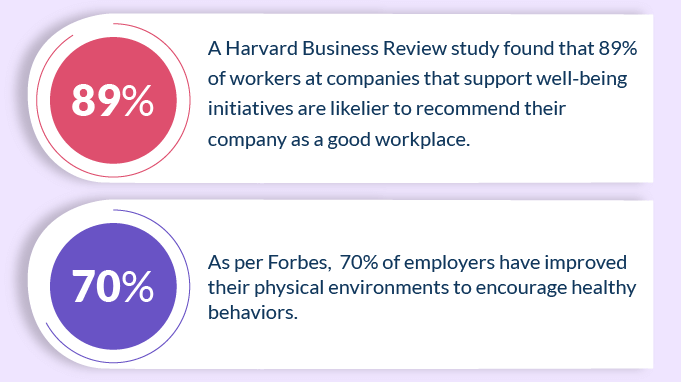
Example:
Spotify emphasizes a culture of belonging, with numerous employee resource groups and initiatives that support diversity and inclusion.
The multinational tech giant Cisco has an elaborate strategy to engage with its employees. It has a series of programs that facilitate communication and employee feedback. For example, birthday chats allow top executives like the Chairperson and the CEO to spend at least one special day with employees and answer their questions. Platforms that enable employees to voice their concerns increase employee engagement and, thus, productivity.
13. Strengthen the Workforce with Team Building Activities
Shared experiences and collaboration can work wonders to help strengthen bonds among colleagues, break down communication barriers, and create a cohesive and motivated workforce. To promote team-building activities, you should;
- Organize team-building exercises and social events.
- Adapt activities for remote or hybrid teams.
- Facilitate workshops for cross-functional collaboration.
- Encourage team feedback sessions.
Statistics:
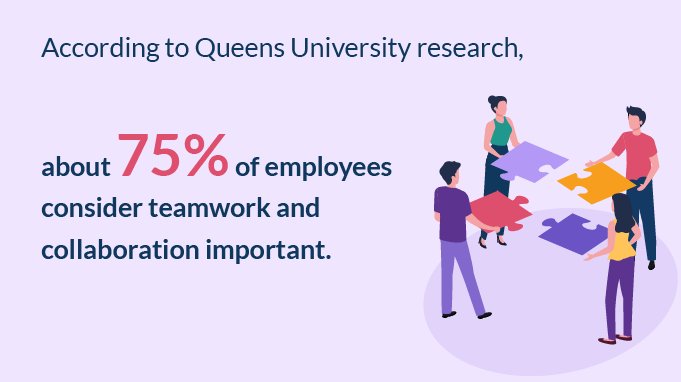
Example:
Dropbox, a file hosting service, organizes "Hack Week," where employees brainstorm and execute new ideas, promoting collaboration.
Colart, a global market leader in art materials, has varied offerings. New joiners take art classes to connect with the brand and products. Employees are encouraged to get involved in projects outside of their roles. Consequently, many employees find new passions and change roles completely. With an open office plan, a stranger walking through has no idea who the execs are, encouraging openness to share ideas.
14. Diversify Your Rewards Scheme
A flexible rewardssystem, offering a range of incentives from monetary bonuses to personalized experiences, acknowledges employees' unique contributions and motivates them effectively. To diversify your rewards, you can;
- Offer both monetary and non-monetary rewards
- Let employees choose rewards that matter to them.
- Implement peer-nominated awards.
- Recognize efforts both publicly and privately.
Statistics:
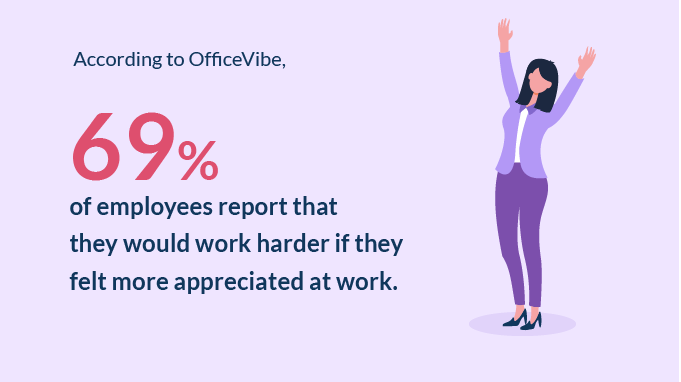
Example:
Airbnb gives its employees travel credit as a unique reward, encouraging them to use their platform and understand the customer experience. Similarly, TripAdvisor reimburses personal travel as part of its global lifestyle benefit.
Tata Consultancy Services (TCS) has a diverse rewards program that includes financial bonuses and global exposure opportunities.
Domino's provides its employees with profit-sharing and other performance-based incentives.
15. Amplify Engagement Efforts through Social Media
Leveraging the power of social media is a modern approach to boosting employee engagement. In the age of connectivity, utilizing social media is an excellent tool to engage, connect, and inspire your workforce. To foster a sense of pride and recognition among employees, an organization can;
- Share employee achievements on company social media channels.
- Encourage employees to share company achievements.
- Organize social media challenges and campaigns.
- Highlight employee stories and testimonials.
- Use platforms like LinkedIn for professional growth and networking
Statistics:

Example:
Dell's "Social Media and Communities University" program trains employees to advocate for the company online, turning them into brand ambassadors.
Starbucks shares employee stories and moments on its Instagram, showcasing its company culture and values.
Telecom company AT&T is a prime example of a company that uses social media to create transparency, using social platforms to share news and provide continuous updates to consumers in case of any outages in any region.
16. Support Career Growth and Personal Development
Supporting career growth and personal development is a win-win strategy that leads to a more engaged and fulfilled workforce, ultimately benefiting both employees and the company. Organizations that prioritize career development and offer opportunities for personal growth attract and retain top talent. To actively invest in employees' long-term success, you should;
- Provide opportunities for skill enhancement.
- Offer guidance on career progression within the organization.
- Provide resources for online courses and certifications.
- Implement a clear career progression path.
- Encourage cross-departmental job shadowing.
Statistics:
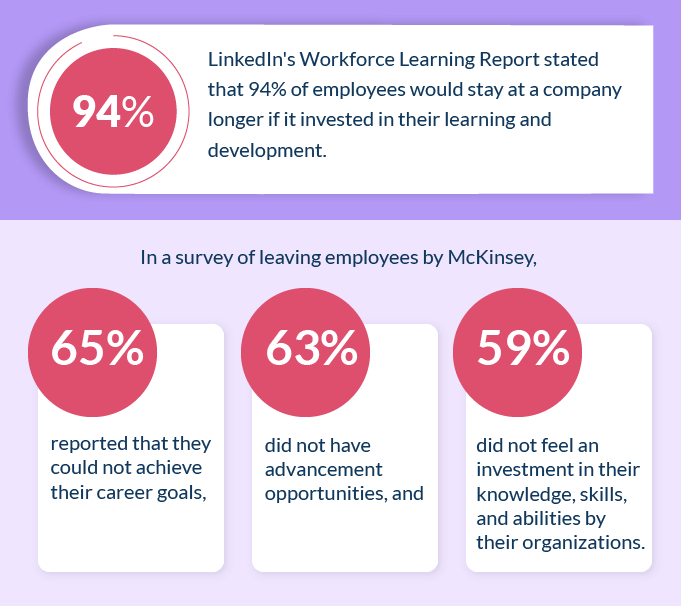
Example:
General Electric's leadership programs are renowned for nurturing future leaders, with many alumni occupying C-suite positions across industries.
Bharti Airtel offers flexible work hours and 6 months' leave for personal and educational purposes.
At Mastercard, employees can take job-rotation opportunities soon after joining the company. Mastercard also actively helps employees plan their career paths and trajectories and offers tools to help them identify the specific skills they need.
Atlas Hotels prioritizes employee growth and development. They offer a variety of training opportunities to help their employees stay on top of industry trends, as well as specialized classes to help them better understand the business.
17. Conduct Timely Surveys
Timely surveys provide a structured platform for employees to voice their opinions, enabling your organization to promptly make data-driven decisions and address issues. They enhance communication and demonstrate your commitment to listening and adapting to your team's evolving needs, ultimately strengthening engagement and trust within your organization. To know the pulse of your employees, you should;
- Regularly collect feedback on employee satisfaction.
- Schedule regular feedback sessions with employees.
- Use anonymous surveys to gather honest opinions.
- Analyze feedback data to identify areas of improvement.
- Implement changes based on survey results and communicate them to the team.
Statistics:
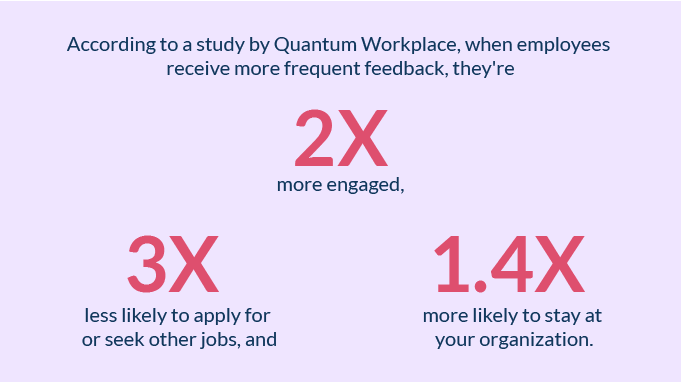
Organizations widely use tools like SurveyMonkey and *Typeform *to gather employee feedback and insights.
Example:
Adobe replaced its traditional performance reviews with a system called "Check-In." This approach focuses on regular feedback, increasing employee satisfaction and performance.
While Microsoft engages its employees through the AskHR software, this system facilitates a smooth interaction with the management, thus giving them insights into the workforce's needs.
FedEx offers an annual survey and feedback action program to track employee relations. Employees provide valuable feedback, and management meets to discuss results. The program allows problem assessment and resolution opportunities. FedEx Corporation provides an efficient way to address problems and balance the community.
18. Celebrate Special Occasions
Celebrating special occasions within the workplace goes beyond mere festivities; it's a strategic approach to enhance employee engagement. Such celebrations not only boost morale but also strengthen the bonds between colleagues. To ensure a more cohesive and motivated workforce within the organization, you can;
- Recognize birthdays, work anniversaries, and cultural celebrations.
- Organize events for major festivals and holidays.
- Create a culture where every achievement, big or small, is celebrated.
Statistics:

Example:
Google is known for its vibrant work culture, celebrating various global festivals and personal milestones, and making employees feel valued and included.
Similarly, Salesforce celebrates "Dreamforce," an annual event focusing on product launches and celebrating the company's achievements and its employees.
Southwest Airlines cares for its people in bad times, not just good ones. The airline openly recognizes deaths, births, and other major events in the lives of people and their families. It has even established a Catastrophic Fund to provide aid when needed.
Conclusion
As we conclude our exploration of these employee engagement best practices, it's evident that the formula for a healthier, more productive workforce combines science and a touch of art. So, as you implement these practices, consider them the essential ingredients in your workplace's culture's secret recipe.
Stay professional, but don't forget to add a dash of fun. After all, the best workplaces find joy in their journey. Here's to your workforce's well-being and to a future where 'work' is synonymous with 'wonderful’.













